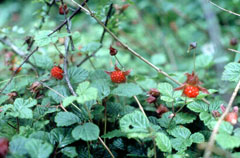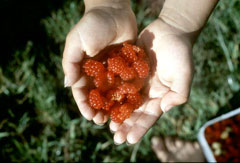 |
|
(c) 2010 Ken Fern & Plants For A Future |
 |
| (c) 2010 Ken Fern & Plants For A Future |
Translate this page:
Summary
Physical Characteristics

 Rubus nepalensis is an evergreen Shrub growing to 0.2 m (0ft 8in) by 1 m (3ft 3in) at a medium rate.
Rubus nepalensis is an evergreen Shrub growing to 0.2 m (0ft 8in) by 1 m (3ft 3in) at a medium rate.
See above for USDA hardiness. It is hardy to UK zone 8 and is frost tender. It is in leaf all year, in flower from June to July, and the seeds ripen from July to August. The species is hermaphrodite (has both male and female organs) and is pollinated by Insects. The plant is self-fertile.
Suitable for: light (sandy), medium (loamy) and heavy (clay) soils and prefers well-drained soil. Suitable pH: mildly acid, neutral and basic (mildly alkaline) soils. It can grow in semi-shade (light woodland) or no shade. It prefers moist soil.
UK Hardiness Map
US Hardiness Map
Synonyms
R. barbatus. R. nutans. non Vest. R. nutantiflorus.
Plant Habitats
Woodland Garden Sunny Edge; Dappled Shade; Ground Cover; Cultivated Beds;
Edible Uses
Edible Parts: Fruit
Edible Uses:
Fruit - raw or cooked[1, 105]. A very well flavoured and reasonably sized raspberry with just a little sourness[K]. It generally fruits well in the garden, though there are some forms that produce very little fruit, or poorly shaped fruits[K].
References More on Edible Uses
Medicinal Uses
Plants For A Future can not take any responsibility for any adverse effects from the use of plants. Always seek advice from a professional before using a plant medicinally.
None known
References More on Medicinal Uses
The Bookshop: Edible Plant Books
Our Latest books on Perennial Plants For Food Forests and Permaculture Gardens in paperback or digital formats.

Edible Tropical Plants
Food Forest Plants for Hotter Conditions: 250+ Plants For Tropical Food Forests & Permaculture Gardens.
More

Edible Temperate Plants
Plants for Your Food Forest: 500 Plants for Temperate Food Forests & Permaculture Gardens.
More

More Books
PFAF have eight books available in paperback and digital formats. Browse the shop for more information.
Shop Now
Other Uses
Dye
A purple to dull blue dye is obtained from the fruit[168]. An excellent ground-cover plant, forming a quite effective weed-suppressing mulch[K].
Special Uses
Food Forest Ground cover
References More on Other Uses
Cultivation details
Easily grown in a good well-drained loamy soil in sun or semi-shade[1, 11, 200]. Prefers a sheltered semi-shady position[11]. Plants survive considerable neglect, they can grow and spread in long grass though they do not fruit well in such a position[K]. Plants are not very drought tolerant[K]. The Nepalese raspberry is a very ornamental plant, though it loses some of its leaves in a cold winter and can look a little bedraggled at this time[K]. It is also unhappy in exposed maritime situations and in a sunny position in very hot summers. A report that this species is not hardy in zones colder than 9 is very questionable, the plant has survived quite hard frosts with us in Cornwall and grows happily at Kew Gardens[K]. There is also a clump growing successfully in a sheltered position in the semi-shade of trees at Cambridge Botanical gardens, this fruited quite well in the summer of 1996[K]. Plants in this genus are notably susceptible to honey fungus[200]. In garden design, as well as the above-ground architecture of a plant, root structure considerations help in choosing plants that work together for their optimal soil requirements including nutrients and water. The root pattern is suckering with new plants from runners away from the plant [2-1].
References Carbon Farming Information and Carbon Sequestration Information
Temperature Converter
Type a value in the Celsius field to convert the value to Fahrenheit:
Fahrenheit:
The PFAF Bookshop
Plants For A Future have a number of books available in paperback and digital form. Book titles include Edible Plants, Edible Perennials, Edible Trees,Edible Shrubs, Woodland Gardening, and Temperate Food Forest Plants. Our new book is Food Forest Plants For Hotter Conditions (Tropical and Sub-Tropical).
Shop Now
Plant Propagation
Seed - requires stratification, is best sown in early autumn in a cold frame. Sow stored seed as early as possible in the year in a cold frame and stratify for a month at 3°c if sowing later than February. Prick out the seedlings when they are large enough to handle and grow on in a cold frame. Plant them out into their permanent positions in late spring of the following year. Tip layering in July. Plant out in autumn. Division in early spring. Very easy, the plants can be divided successfully at almost any time of the year. Larger divisions can be planted out direct into their permanent positions. We have found it best to pot up the smaller divisions and grow them on in a lightly shaded position in a cold frame, planting them out once they are well established in the summer.
Other Names
If available other names are mentioned here
Native Range
TROPICAL ASIA: India (Himalayan region), Nepal,
Weed Potential
Right plant wrong place. We are currently updating this section.
Please note that a plant may be invasive in one area but may not in your area so it's worth checking.
Conservation Status
IUCN Red List of Threatened Plants Status :

Growth: S = slow M = medium F = fast. Soil: L = light (sandy) M = medium H = heavy (clay). pH: A = acid N = neutral B = basic (alkaline). Shade: F = full shade S = semi-shade N = no shade. Moisture: D = dry M = Moist We = wet Wa = water.
Now available:
Food Forest Plants for Mediterranean Conditions
350+ Perennial Plants For Mediterranean and Drier Food Forests and Permaculture Gardens.
[Paperback and eBook]
This is the third in Plants For A Future's series of plant guides for food forests tailored to
specific climate zones. Following volumes on temperate and tropical ecosystems, this book focuses
on species suited to Mediterranean conditions—regions with hot, dry summers and cool, wet winters,
often facing the added challenge of climate change.
Read More
Expert comment
Author
(Hook.f.)Kuntze.
Botanical References
1151200
Links / References
For a list of references used on this page please go here
Readers comment
| Add a comment |
|
If you have important information about this plant that may help other users please add a comment or link below. Only comments or links that are felt to be directly relevant to a plant will be included. If you think a comment/link or information contained on this page is inaccurate or misleading we would welcome your feedback at [email protected]. If you have questions about a plant please use the Forum on this website as we do not have the resources to answer questions ourselves.
* Please note: the comments by website users are not necessarily those held by PFAF and may give misleading or inaccurate information.
To leave a comment please Register or login here All comments need to be approved so will not appear immediately.
|
Subject : Rubus nepalensis
|
|
|
|